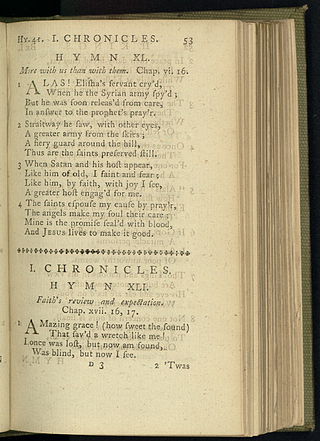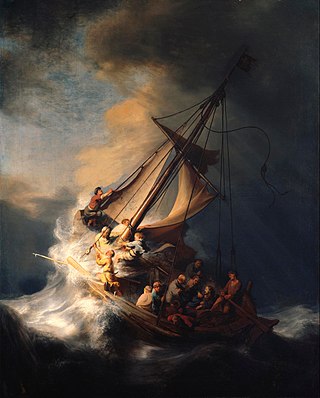Related Research Articles

"Amazing Grace" is a Christian hymn published in 1779, written in 1772 by English Anglican clergyman and poet John Newton (1725–1807). It is an immensely popular hymn, particularly in the United States, where it is used for both religious and secular purposes.

A hymn is a type of song, and partially synonymous with devotional song, specifically written for the purpose of adoration or prayer, and typically addressed to a deity or deities, or to a prominent figure or personification. The word hymn derives from Greek ὕμνος (hymnos), which means "a song of praise". A writer of hymns is known as a hymnist. The singing or composition of hymns is called hymnody. Collections of hymns are known as hymnals or hymn books. Hymns may or may not include instrumental accompaniment. Polyhymnia is the Greco/Roman goddess of hymns.

Contemporary Christian music (CCM), also known as Christian pop, and occasionally inspirational music, is a genre of modern popular music, and an aspect of Christian media, which is lyrically focused on matters related to the Christian faith and stylistically rooted in Christian music. Originating in the United States, it was formed by those affected by the 1960s Jesus movement revival who began to express themselves in other styles of popular music, beyond the church music of hymns, gospel and Southern gospel music that was prevalent in the church at the time. Initially referred to as Jesus music, today, the term is typically used to refer to pop, but also includes rock, alternative rock, hip hop, metal, contemporary worship, punk, hardcore punk, Latin, electronic dance music, R&B-influenced gospel, and country styles.
A doxology is a short hymn of praises to God in various forms of Christian worship, often added to the end of canticles, psalms, and hymns. The tradition derives from a similar practice in the Jewish synagogue, where some version of the Kaddish serves to terminate each section of the service.

"John Brown's Body" is a United States marching song about the abolitionist John Brown. The song was popular in the Union during the American Civil War. The song arose out of the folk hymn tradition of the American camp meeting movement of the late 18th and early 19th century. According to an 1889 account, the original John Brown lyrics were a collective effort by a group of Union soldiers who were referring both to the famous John Brown and also, humorously, to a Sergeant John Brown of their own battalion. Various other authors have published additional verses or claimed credit for originating the John Brown lyrics and tune.

The "Battle Hymn of the Republic", also known as "Mine Eyes Have Seen the Glory" or "Glory, Glory Hallelujah" outside of the United States, is an American patriotic song that was written by abolitionist writer Julia Ward Howe during the American Civil War.

Frances Ridley Havergal was an English religious poet and hymnwriter. Take My Life and Let it Be and Thy Life for Me are two of her best known hymns. She also wrote hymn melodies, religious tracts, and works for children. She did not occupy, and did not claim for herself, a prominent place as a poet, but she carved out a niche for herself.

"Christ the Lord Is Risen Today" is a Christian hymn associated with Easter. Most of the stanzas were written by Charles Wesley, and the hymn appeared under the title "Hymn for Easter Day" in Hymns and Sacred Poems by Charles and John Wesley in 1739. The hymn eventually became well known for the "Alleluia" sung as a melisma after each line, which was added by an unknown author, probably to fit the commonly used hymn tune, "Easter Hymn". It remains a traditional processional hymn on Easter Sunday.

Psalm 23 is the 23rd psalm of the Book of Psalms, beginning in English in the King James Version: "The Lord is my shepherd". In Latin, it is known by the incipit, "Dominus regit me". The Book of Psalms is part of the third section of the Hebrew Bible, and a book of the Christian Old Testament. In the slightly different numbering system used in the Greek Septuagint and Latin Vulgate translations of the Bible, this psalm is Psalm 22.

"Rock of Ages" is a popular Christian hymn written by the Reformed Anglican minister Augustus Toplady.

"Eternal Father, Strong to Save" is a British hymn traditionally associated with seafarers, particularly in the maritime armed services. Written in 1860, its author, William Whiting, was inspired by the dangers of the sea described in Psalm 107. It was popularised by the Royal Navy and the United States Navy in the late 19th century, and variations of it were soon adopted by many branches of the armed services in the United Kingdom and the United States. Services who have adapted the hymn include the Royal Marines, Royal Air Force, the British Army, the Royal Australian Navy, the United States Coast Guard, United States Marine Corps and the United States Space Force, as well as the navies of many other Commonwealth realms. Accordingly, it is known by many names, variously referred to as the Hymn of His Majesty's Armed Forces, the Royal Navy Hymn, the United States Navy Hymn, and sometimes by the last line of its first verse, "For Those in Peril on the Sea". The hymn has a long tradition in civilian maritime contexts as well, being regularly invoked by ship's chaplains and sung during services on ocean crossings.

"Onward, Christian Soldiers" is a 19th-century English hymn. The words were written by Sabine Baring-Gould in 1865, and the music was composed by Arthur Sullivan in 1871. Sullivan named the tune "St Gertrude," after the wife of his friend Ernest Clay Ker Seymer, at whose country home he composed the tune. The Salvation Army adopted the hymn as its favoured processional. The piece became Sullivan's most popular hymn. The hymn's theme is taken from references in the New Testament to the Christian being a soldier for Christ, for example II Timothy 2:3 (KJV): "Thou therefore endure hardness, as a good soldier of Jesus Christ."

"Es ist ein Ros entsprungen" is a Christmas carol and Marian hymn of German origin. It is most commonly translated into English as "Lo, how a rose e'er blooming" and is also called "A Spotless Rose" and "Behold a Rose of Judah". The rose in the German text is a symbolic reference to the Virgin Mary. The hymn makes reference to the Old Testament prophecies of Isaiah, which in Christian interpretation foretell the Incarnation of Christ, and to the Tree of Jesse, a traditional symbol of the lineage of Jesus. Because of its prophetic theme, the hymn is popular during the Christian season of Advent.

Charlotte Elliott was an English poet, hymn writer, and editor. She is best known by two hymns, "Just As I Am" and "Thy will be done".
"As with Gladness Men of Old" is an Epiphany hymn, written by William Chatterton Dix on 6 January 1859 (Epiphany) while he was ill in bed. Though considered by many as a Christmas carol, it is found in the Epiphany section of many hymnals and still used by many churches. The music was adapted by William Henry Monk in 1861 from a tune written by Conrad Kocher in 1838. The hymn is based on the visit of the Biblical magi in the Nativity of Jesus.

"We Plough the Fields and Scatter" is a hymn of German origin commonly associated with harvest festival. Written by poet Matthias Claudius, "Wir pflügen und wir streuen" was published in 1782 and set to music in 1800 attributed to Johann A. P. Schulz. It was translated into English by Jane Montgomery Campbell in 1861. It appears in a shortened form in the musical Godspell, as the song, "All Good Gifts". It is among the most performed of hymns in the United Kingdom.

"Come, Thou Long Expected Jesus" is a 1744 Advent and Christmas carol common in Protestant hymnals. The text was written by Charles Wesley. It is performed to one of several tunes, including "Stuttgart", "Hyfrydol", and "Cross of Jesus". The hymn is considered an enduring classic in Christian hymnody.

"And Can It Be That I Should Gain?" is a Christian hymn written by Charles Wesley in 1738 to celebrate his conversion, which he regarded as having taken place on 21 May of that year. The hymn celebrates personal salvation through the death and resurrection of Jesus, and is one of the most popular Methodist hymns today.

"Lift High the Cross" is a 19th century English Christian hymn. It was written in 1887 by George Kitchin and revised in 1916 by Michael R. Newbolt.
Hymnody in continental Europe developed from early liturgical music, especially Gregorian chant. Music became more complicated as embellishments and variations were added, along with influences from secular music. Although vernacular leisen and vernacular or mixed-language carols were sung in the Middle Ages, more vernacular hymnody emerged during the Protestant Reformation, although ecclesiastical Latin continued to be used after the Reformation. Since then, developments have shifted between isorhythmic, homorhythmic, and more rounded musical forms with some lilting. Theological underpinnings influenced the narrative point of view used, with Pietism especially encouraging the use of the first person singular. In the last several centuries, many songs from Evangelicalism have been translated from English into German.
References
- 1 2 Julian, John (1892). A Dictionary of Hymnology: Setting Forth the Origin and History of Christian Hymns of All Ages and Nations. C. Scribner's Sons. p. 888.
- 1 2 3 4 Canada, Church of England in (1909). The Book of Common Praise: Being the Hymn Book of the Church of England in Canada. H. Frowde, Oxford University Press. pp. 574–576. ISBN 978-0-665-73815-9.
- ↑ Wright, William Henry Kearley (1896). West-country Poets: Their Lives and Works. Being an Account of about Four Hundred Verse Writers of Devon and Cornwall, with Poems and Extracts. London: Elliot Stock. p. 33.
- ↑ Wainwright, Geoffrey (1984). Doxology: A Systematic Theology. OUP USA. p. 448. ISBN 978-0-19-520433-9.
- ↑ Osbeck, Kenneth W. (1982). 101 Hymn Stories. Kregel Publications. pp. 74–75. ISBN 978-0-8254-9327-0.
- ↑ Petersen, William; Petersen, Ardythe (2015-01-12). The Complete Book of Hymns. Tyndale House Publishers, Inc. p. 311. ISBN 978-1-4143-3140-9.
- ↑ Bullinger, E. W. (2016-07-21). The Companion Bible. Ravenio Books.